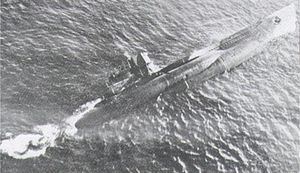Name U-617 Yard number 593 Commissioned 9 April 1942 Launched 14 February 1942 Draft 4.74 m Builder Blohm + Voss | Ordered 15 August 1940 Laid down 31 May 1941 Construction started 31 May 1941 Length 67 m Beam 6.18 m | |
 | ||
Fate Ran aground 12 September 1943 at position near Melilla then destroyed by combined RAF & FAA aircraft and Royal Navy & Royal Australian Navy surface ships. Part of | ||
German submarine U-617 was a Type VIIC U-boat built for Nazi Germany's Kriegsmarine for service during World War II. She was laid down on 31 May 1941 by Blohm & Voss in Hamburg as yard number 593, launched on 14 February 1942 and commissioned on 9 April under Kapitänleutnant Albrecht Brandi.
Contents
The boat's service began on 9 April 1942 with training as part of the 5th U-boat Flotilla. She was transferred to the 7th flotilla on 1 September 1942 and moved on to the 29th flotilla on 1 December 1942.
Design
German Type VIIC submarines were preceded by the shorter Type VIIB submarines. U-617 had a displacement of 769 tonnes (757 long tons) when at the surface and 871 tonnes (857 long tons) while submerged. She had a total length of 67.10 m (220 ft 2 in), a pressure hull length of 50.50 m (165 ft 8 in), a beam of 6.20 m (20 ft 4 in), a height of 9.60 m (31 ft 6 in), and a draught of 4.74 m (15 ft 7 in). The submarine was powered by two Germaniawerft F46 four-stroke, six-cylinder supercharged diesel engines producing a total of 2,800 to 3,200 metric horsepower (2,060 to 2,350 kW; 2,760 to 3,160 shp) for use while surfaced, two Brown, Boveri & Cie GG UB 720/8 double-acting electric motors producing a total of 750 metric horsepower (550 kW; 740 shp) for use while submerged. She had two shafts and two 1.23 m (4 ft) propellers. The boat was capable of operating at depths of up to 230 metres (750 ft).
The submarine had a maximum surface speed of 17.7 knots (32.8 km/h; 20.4 mph) and a maximum submerged speed of 7.6 knots (14.1 km/h; 8.7 mph). When submerged, the boat could operate for 80 nautical miles (150 km; 92 mi) at 4 knots (7.4 km/h; 4.6 mph); when surfaced, she could travel 8,500 nautical miles (15,700 km; 9,800 mi) at 10 knots (19 km/h; 12 mph). U-617 was fitted with five 53.3 cm (21 in) torpedo tubes (four fitted at the bow and one at the stern), fourteen torpedoes, one 8.8 cm (3.46 in) SK C/35 naval gun, 220 rounds, and an anti-aircraft gun. The boat had a complement of between forty-four and sixty.
Service history
In seven patrols she sank eleven ships for a total of 25,879 gross register tons (GRT), plus two warships and one auxiliary warship.
Wolfpacks
In addition she took part in five wolfpacks, namely,
Fate
She ran aground on 12 September 1943 at position 35°38′N 03°27′W near Melilla after a sustained air attack by Leigh light-equipped RAF Wellington bombers from 179 Squadron.
All crew members were able to evacuate the stricken sub and subsequently interned by the Spanish authorities. They were later repatriated to Germany.
The abandoned submarine was then finished off with combined RAF Hudson and FAA Swordfish aircraft from Gibraltar and gunfire from HMS Hyacinth and HMAS Wollongong.
